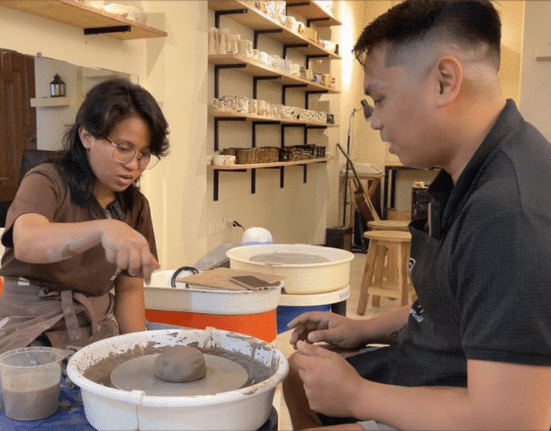If one asked where they could take pottery classes in the country, more often than not, they would be referred to places outside the metro, such as Sagada in Mountain Province.
The travel time from Manila to Sagada would take approximately 12 hours. However, not everyone has the luxury to travel that far and spend money on accommodations in the area.
To solve this dilemma, a few ceramic artists have opened studios in the metro and one of them is Ianna Engaño, also known as “Odangputik.”
Engaño is a 27-year-old ceramic artist who owns Odangputik Pottery, a studio located in Tandang Sora, Quezon City.
Before it became a physical studio, Odangputik Pottery was an online store Engaño established in 2020, during the height of the pandemic, when many people lost their source of income, including her.

Along with her partner, Lin Bajala, Engaño started selling ceramic products such as pots and mugs with socio-political concepts. The artist thought of this theme because, during that time, the only source that people had was news since in-person interactions were limited.
It is Engaño’s job to make the products, while Bajala helps her with copywriting to market her works online.
This online shop concept continued until the duo decided to turn it into a physical studio that aims not only to sell ceramic products but also to bring pottery closer to people in Metro Manila.
After years of hard work, Odangputik Pottery Studio was born in June 2023, with Engaño as the studio’s artist and Bajala as its director.
Bajala shared with republicasia that they chose Quezon City as their location because, based on their data, many people are taking an interest in pottery in the area.
“We want pottery to be more accessible to more Filipinos, and we also want it to be affordable for Filipinos, kaya di kami dito nag relocate sa Quezon City, the studio director said.
“They can learn pottery the right way here sa amin. Ayaw din naman naming magturo ng mga mali-mali about pottery techniques, kaya kami na mismo ‘yung gagawa ng mission na ‘yon,” she added.
Learning pottery in the Odangputik studio has a lot of twists. Since the pandemic limited face-to-face interactions, Bajala thought of adding more excitement for their students by also holding different events, alongside their pottery classes.
The most famous one is their pottery blind date for all their single students. They also have family bonding events and live music sessions, to name a few.
Love for arts, finding love
Odangputik Pottery would not have been established if it were not for Engaño and Bajala’s love for pottery.

Since childhood, mud has always been a part of Engaño’s everyday life, especially during her playtime with her friends.
“Dati kasi sa Bacoor, noong marami pang palayan doon, naglalaro talaga kami ng putik, with kalabaw, ganyan, cows. So bata palang ako, may touch na ako ng putik pero hindi namin ‘yun niluluto,” she recalled.
“Noong nakapaglaro ako ng putik, sabi ko balang araw magiging magpuputik ako or i-e-explore ko ‘yung medium na ‘to,” she continued.
True to her word, Engaño took up Visual Communication as her college program at the University of the Philippines. In 2013, she was given the opportunity to explore pottery at the UP Ceramics Studio, which was newly-opened at the time.
“Lagi akong nakatambay doon so, tuloy-tuloy na hanggang ngayon. Ang addicting kasi ng putik eh,” Engaño said.
It was through pottery Engaño met Bajala. Like her, Bajala, who was from the finance industry, also took an interest in art.
The two started talking through a dating application, where they often talked about their love for art.
“Doon talaga kami nagkasundo, kasi ako, parang mas gusto ko rin pasukin ‘yung creative industry. Unti-unti kong pinapasok ‘yung sarili ko talaga sa creative industry.
And then ayon, when we were talking about art, mas naka-focus kami sa ceramics,” Bajala said.
Engaño, meanwhile, would also share with Bajala a lot about her projects, one of which was her thesis, which was shortlisted for best thesis.
Challenges
But Engaño’s ceramic journey is not without challenges. The first one would be balancing her time as a working student.
Engaño recalled that she had to do all her school readings and plates inside a train and catch up on sleep on a bus. She would go straight to the university rather than go home since she knew she would arrive there at midnight.
The second challenge was finding resources for her ceramic works, since pottery at that time had not evolved yet. One of the major problems facing the ceramics community at UP is the lack of a kiln, a chamber where clays are cooked to become ceramic.
“Before, mga 2000, mga ganong year, wala kaming mapaglutuan,” she said.
The only person who has a kiln among them is her “putik sister,” Ayori. However, Engaño had to travel with her works from Bacoor to Fairview, where Ayori’s studio is located.
“Siya naman ‘yun kiln operator, pero still kailangan mo pa rin maging involved doon sa firing kasi responsibility mo ‘yun, artworks mo ‘yon eh at the end of the day,” the ceramic artist said.
There was also a time when she had to ask her other “putik friend” in Los Baños to turn her works into ceramics.
Growing interest in pottery
Fortunately, pottery is once again gaining a lot of interest, particularly from the new generation.
One of them is Odangputik’s 28-year-old pottery student, Gelo Asuncion.

Asuncion shared with republicasia that he is also a fan of the arts, with photography being his hobby. He wanted to widen his creative side, so he decided to also immerse himself in pottery, which he first saw in Sagada.
“Since nakita ko siya sa Sagada, sobrang interesting din kasi how to do plates, how to do mugs na gawa sa putik and what not,” he said.
For Asuncion, pottery taught him more than just the art process itself.
“Mas marami kang matututunan [tulad ng] patience, mag-i-improve yung attitude mo. para kang nagco-contemplate at the same time kapag nag[po-pottery] ka,” he emphasized.
Pottery is both fun and fulfilling, Asuncion said.

“From the putik itself, hindi mo alam kung anong gagawin mo, di mo alam kung ano yung mangyayari, but at the end, makikita mo yung gawa mo, yung obra mo,” he stressed.
“Through the process from the dome, ginawa mo siyang baso, then di mo akalaing pwede mo siyang gawing plate or platito or bowl. Sobrang saya pwede kang gumawa ng kahit ano,” he continued.
For those who want to try pottery, Engaño advises them to invest first in their values and skill set.
“Very important element naman kasi diyan is fire, air, water, and earth. So yun lang naman yung kailangan din, yung skill set mo. Oo, sa knowledge about sa pagpo-pottery. Trial and error, kasi hindi mo naman talaga kailangan ng mga fancy tools para makaprovide ng pottery kasi katulad niyan earthenware,” she explained.
They also have to equip themselves with more knowledge about the art process by reading books and finding online information about it. It is also important for them to experience trial-and-error because, through this, they will realize how much they can learn about pottery.
Their pottery journey might not be easy at first, but Bajala made sure that it would all be worth it.
“Hindi naman talaga totoo, hindi true na walang pera sa art. Meron at meron yan, pero, hindi siya magiging madali sa simula,” the studio director said, adding, “mahabang proseso talaga siya, so you need to take that long process, walang instant sa art.”
Develop pottery industry
With the growing interest in the old decorative arts, Odangputik Pottery has another mission to accomplish: develop the pottery industry in the Philippines.
Bajala said that they plan to go on a nationwide tour to help potters promote their works. One example are potters from South Cotabato, where a local source of clay can be found. The studio director said they plan to visit the potters in the area to see what else they can do to help them.

They also have an upcoming campaign that is part of the “Art and Beyond” campaign dedicated to artists. This campaign targets school-age kids who are artistically-inclined but don’t have the means to go to an art school or to develop their skills.
“Pwede namin silang i-adopt para i-train dito sa studio, and then iga-guide sila sa career path nila para maging artist sila kasi sa mga remote provinces, ang mga uso naman na professions, gusto nila maging teacher, maging doctor, maging lawyer,” Bajala said.
While this does not mean that these professions are not important, Bajala said that not all kids have the same interests and strengths.
“Paano naman ’yung mga artistically inclined na kids bakit mo sila ipipilit sa medical field kung hindi sila para doon? So ‘yun ‘yung sa sa mga notion na gusto naming baguhin dito sa Pilipinas,” she continued.
Odangputik Pottery has a student from Antique, who first learned the craft when he was 12 years old. The kid, named Nhel, is now 20 years old and is an expert in making a “palayok,” a clay pot used in traditional Filipino cuisine.
Bajala stressed that the Odangputik Pottery wanted such a tradition not to vanish, and so they brought it to the city to introduce it to their clients.
“‘Yung sa Antique meron siyang pukpok palayok, ‘yung mga elders na lang kasi ‘yung halos gumagawa noon. So sana makagawa rin kayo ng paraan para hindi maputol ‘yung ganong klaseng tradition kasi it’s important in our culture also,” she said.
More than just a decoration
While ceramics are visually appealing, their purpose does not end there.

These can be used as functional ware that one can use in their everyday living. It can serve as tablewares since one can make mugs, bowls, plates, or cups out of pottery.
It can be a ‘’vessel of dialogue,’’ as ceramic artists use their craft to advocate for social issues.
“When you put up a sculpture out of ceramics, pwede mo kasi ilagay dun yung kwento eh. Tapos, it can be your way to express what you would want others to know,” Engaño said.
“For example si Oda, more on socio political commentaries, environmental awareness, or parang mga poverty alleviation. Pwedeng magsimula tayo na gamitin natin yung art form or pottery para makapag-provide ng livelihood sa iba, to help with poverty alleviation din,” Bajala suggested.
Taking action for what they advocate for can really make a difference, and pottery can be a good platform for it, she added.
How useful was this post?
Click on a star to rate it!
Average rating 0 / 5. Vote count: 0
No votes so far! Be the first to rate this post.
We are sorry that this post was not useful for you!
Let us improve this post!
Tell us how we can improve this post?







